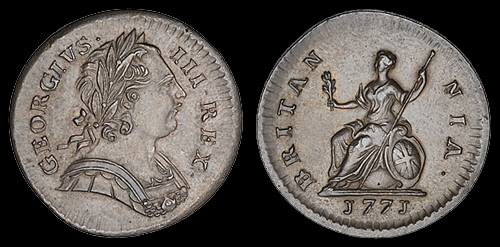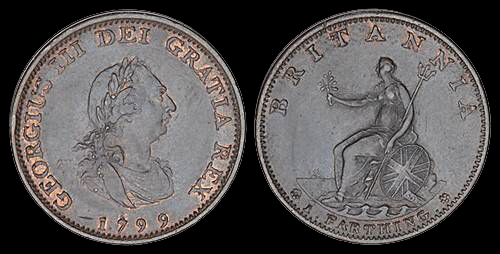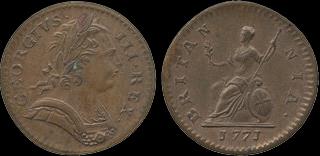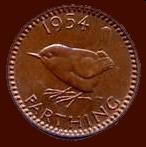








Designed by Nigel G Wilcox






The Paragon Of Metal Detecting
Powered By Sispro1
British Sterling Currency - Numismatics,
Farthing
For Reference ONLY
Everything For The Detectorist


George III Farthing 1760-1820 AD
In the reign of King George III (1760-1820) apart from the "posthumous" George II coins previously mentioned, the first issue of farthings did not come until 1771. Counterfeiting was rampant, and making the production of counterfeit copper coins a felony in 1771 had little effect and for the next twenty years or so the majority of copper so-called coins in circulation were forgeries. Matthew Boulton 's contract in 1797 to produce the Cartwheel pennies and twopences, thwarting the counterfeiters, did not extend to producing the farthing, though Boulton had expected that it would and had prepared several patterns of the appropriate size and weight in accordance with his ideas on the intrinsic value of copper coins. However Boulton was given a licence to produce farthings in 1799. In the meantime the price of copper had risen, and consequently the weight of the coins was reduced slightly compared to the cartwheel design, and the 1799 farthing had a more conventional appearance, although two aspects of the coin were far from conventional: the reverse bore the legend 1 FARTHING, the first time the name of a denomination had ever appeared on an English coin, and it was also the first British coin to have the date on the same side as the king's head. In 1806-1807 a further 22.5 tons of copper was struck into farthings by Boulton, but the price of copper had risen again and the weight was even less than the 1799 issue.
George III farthings were produced in three distinct phases:-
- 1771, 1773-1775 (all years). Weight 4.3-5.3 grams, diameter 23-24 millimetres. Obverse shows a right-facing bust of the king, with the inscription GEORGIVS III REX, reverse shows a left-facing seated Britannia holding a spray and spear, with the inscription BRITANNIA and the date in the exergue beneath Britannia.
- 1799. Weight 5.8-6.6 grams, diameter 23-24 millimetres. Obverse shows a right-facing bust of the king, with the inscription GEORGIVS III DEI GRATIA REX 1799, reverse shows a redesigned left-facing seated Britannia holding a spray and spear, with the inscription BRITANNIA 1 FARTHING.
- 1806-1807. Weight 4.7-4.8 grams, diameter 21-22 millimetres. Obverse shows a right-facing bust of the king, with the inscription GEORGIVS III D G REX date, reverse shows a slightly different left-facing seated Britannia holding a spray and spear, with the inscription BRITANNIA.
After the mint moved from the Tower of London to Tower Hill the production of gold and silver coins took precedence over copper in the Great Recoinage of 1816. The production of copper coins did not resume until the reign of King George IV
Diameter : 23.5mm
Weight : 5.8 - 6.6g
Obverse Design:
George's bust facing right, abbreviated legend is as follows:
GEORGIUS III DEI GRATIA REX
(King George III by the Grace of God)
Reverse Design:
Seated Britannia facing left, holding an olive branch and trident, with a shield at her side. Denomination "1 Farthing" below Britannia in between cinquefoils, legend is as follows: BRITANNIA
In the reign of King George III (1760-1820) apart from the "posthumous" George II coins previously mentioned, the first issue of farthings did not come until 1771. Counterfeiting was rampant, and making the production of counterfeit copper coins a felony in 1771 had little effect and for the next twenty years or so the majority of copper so-called coins in circulation were forgeries. Matthew Boulton 's contract in 1797 to produce the Cartwheel pennies and twopences, thwarting the counterfeiters, did not extend to producing the farthing, though Boulton had expected that it would and had prepared several patterns of the appropriate size and weight in accordance with his ideas on the intrinsic value of copper coins. However Boulton was given a licence to produce farthings in 1799. In the meantime the price of copper had risen, and consequently the weight of the coins was reduced slightly compared to the cartwheel design, and the 1799 farthing had a more conventional appearance, although two aspects of the coin were far from conventional: the reverse bore the legend 1 FARTHING, the first time the name of a denomination had ever appeared on an English coin, and it was also the first British coin to have the date on the same side as the king's head. In 1806-1807 a further 22.5 tons of copper was struck into farthings by Boulton, but the price of copper had risen again and the weight was even less than the 1799 issue.
George III farthings were produced in three distinct phases:-
- 1771, 1773-1775 (all years). Weight 4.3-5.3 grams, diameter 23-24 millimetres. Obverse shows a right-facing bust of the king, with the inscription GEORGIVS III REX, reverse shows a left-facing seated Britannia holding a spray and spear, with the inscription BRITANNIA and the date in the exergue beneath Britannia.
- 1799. Weight 5.8-6.6 grams, diameter 23-24 millimetres. Obverse shows a right-facing bust of the king, with the inscription GEORGIVS III DEI GRATIA REX 1799, reverse shows a redesigned left-facing seated Britannia holding a spray and spear, with the inscription BRITANNIA 1 FARTHING.
- 1806-1807. Weight 4.7-4.8 grams, diameter 21-22 millimetres. Obverse shows a right-facing bust of the king, with the inscription GEORGIVS III D G REX date, reverse shows a slightly different left-facing seated Britannia holding a spray and spear, with the inscription BRITANNIA.
After the mint moved from the Tower of London to Tower Hill the production of gold and silver coins took precedence over copper in the Great Recoinage of 1816. The production of copper coins did not resume until the reign of King George IV
Diameter : 23.5mm
Weight : 5.8 - 6.6g
Obverse Design:
George's bust facing right, abbreviated legend is as follows:
GEORGIUS III DEI GRATIA REX
(King George III by the Grace of God)
Reverse Design:
Seated Britannia facing left, holding an olive branch and trident, with a shield at her side. Denomination "1 Farthing" below Britannia in between cinquefoils, legend is as follows: BRITANNIA
Royal Monarchy
Copyright © All Rights Reserved by Nigel G Wilcox · · E-Mail: ngwilcox100@gmail.com
INFORMATION - DATA
6. S.Menu
Pages

George III
We do NOT buy or sell coins
Farthing

Main Coin Menu

VIEW ALL MENUS
Member NCMD
























